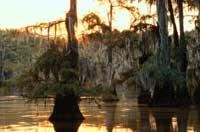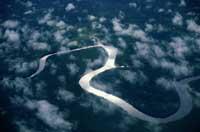Forest composition research

What is the most biodiverse area in the world? The usual thing is to think that this place is Amazonia, but this answer is not entirely correct. According to scientists investigating rainforests, the answer to this question depends on the scale.
The Amazon is home to a fifth of global biodiversity, making it the richest ecosystem in the world. However, researchers from the Smithsonian Institute investigating tropical rainforests have compared the jungles of Panama and the Amazon, obtaining an interesting result. In the jungles of Panama, the composition of two areas far from each other at a certain distance, in terms of tree species, varies much more than in the Amazon.
The areas analyzed are those of the Panama Canal, the Yasuni National Park of Ecuador and the Manu Peruvian Biosphere Reserve. All of them have an approximate area of hectare. For the research, logs of more than ten centimeters in diameter of the three forests were counted and identified, in total about 50,000 trees. A long work and with much patience, no doubt, but that has not been useless: they have seen how much the species of trees change in one and another jungle depending on the distance.

In the Amazon there are two zones 1,000 kilometers from each other with a similar biodiversity. On the other hand, in the Isthmus jungle of Panama, it is enough that two zones are spaced 50 kilometers to see significant differences. These differences in the Amazon can occur in a long route of 1,400 km. Due to these major changes, in terms of tree biodiversity, some areas of Panama are as rich or richer as some areas of the Amazon.
Beta diversity: composition thermometer
But it is not enough to see how much the composition of forests changes. Now they try to measure these changes well and understand why they occur. Richard Condite, director of the research, explained that "environmentalists use a technical term to define changes in forest composition based on distance: beta diversity. When the composition of the jungle changes a lot at a short distance, the beta diversity of the jungle is great and the homogeneous composition is small, as in Peru and Ecuador."
The aim of the research was to define by mathematical models the causes of a great or lesser beta diversity. In fact, although habitat has so far been taken into account to understand the composition of the forest and the capacity of tree seed expansion, this study has also considered extraordinary events. According to the researchers, this is not all wrong, but if we look more deeply at the differences between tropical trees, we have to go further.

Also noteworthy is another study carried out with the same intention in the jungle of Guyana. This work has been done by the Research and Development Institute. 17,000 plants have been identified and, for the first time, have concluded that the number of falling trees affects the composition of the forest. The conclusion is that when few trees fall down the variety of species is very large, while if the forest is old and many trees fall, biodiversity decreases.
That has its logic: when the trees do not fall, the underlying ones submit to the shade, so those who need the warmth of the solar rays and appreciate the shade help each other. It is evident, at least, that researchers try to analyze and understand the composition of forests, and gradually identify all the factors that influence their composition. At least they approach the goal.
Published in the supplement Estación de Gara.
Buletina
Bidali zure helbide elektronikoa eta jaso asteroko buletina zure sarrera-ontzian











